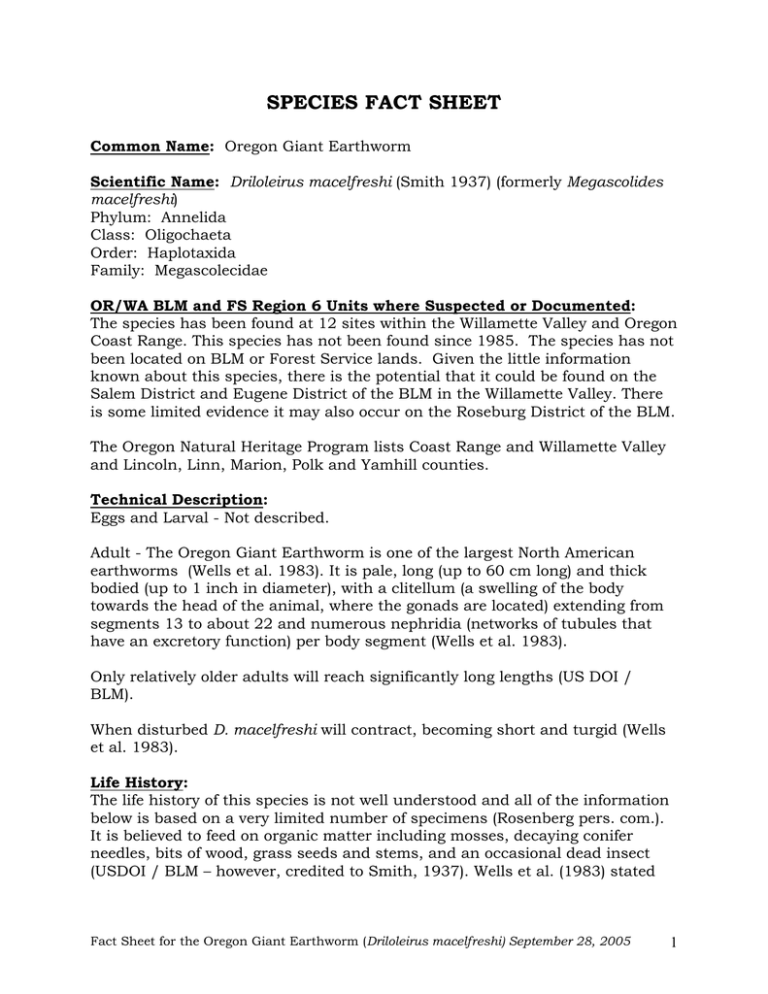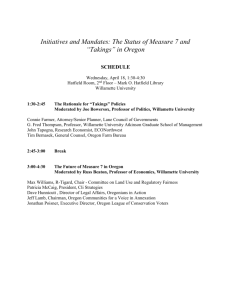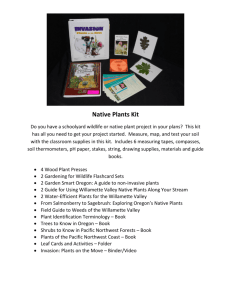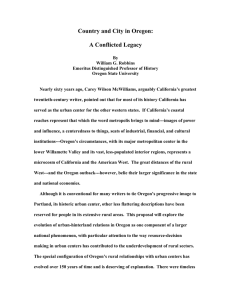SPECIES FACT SHEET
advertisement

SPECIES FACT SHEET Common Name: Oregon Giant Earthworm Scientific Name: Driloleirus macelfreshi (Smith 1937) (formerly Megascolides macelfreshi) Phylum: Annelida Class: Oligochaeta Order: Haplotaxida Family: Megascolecidae OR/WA BLM and FS Region 6 Units where Suspected or Documented: The species has been found at 12 sites within the Willamette Valley and Oregon Coast Range. This species has not been found since 1985. The species has not been located on BLM or Forest Service lands. Given the little information known about this species, there is the potential that it could be found on the Salem District and Eugene District of the BLM in the Willamette Valley. There is some limited evidence it may also occur on the Roseburg District of the BLM. The Oregon Natural Heritage Program lists Coast Range and Willamette Valley and Lincoln, Linn, Marion, Polk and Yamhill counties. Technical Description: Eggs and Larval - Not described. Adult - The Oregon Giant Earthworm is one of the largest North American earthworms (Wells et al. 1983). It is pale, long (up to 60 cm long) and thick bodied (up to 1 inch in diameter), with a clitellum (a swelling of the body towards the head of the animal, where the gonads are located) extending from segments 13 to about 22 and numerous nephridia (networks of tubules that have an excretory function) per body segment (Wells et al. 1983). Only relatively older adults will reach significantly long lengths (US DOI / BLM). When disturbed D. macelfreshi will contract, becoming short and turgid (Wells et al. 1983). Life History: The life history of this species is not well understood and all of the information below is based on a very limited number of specimens (Rosenberg pers. com.). It is believed to feed on organic matter including mosses, decaying conifer needles, bits of wood, grass seeds and stems, and an occasional dead insect (USDOI / BLM – however, credited to Smith, 1937). Wells et al. (1983) stated Fact Sheet for the Oregon Giant Earthworm (Driloleirus macelfreshi) September 28, 2005 1 that D. macelfreshi feeds on pure organic residues, with only a slight mixture of soil. In response to disturbance, it will produce a saliva with a flowery odor (smells like lilies) that is hypothesized by William Fender to be some sort of chemical defense (Fender 1995). Activity generally takes place near the surface; however it is believed D. macelfreshi can go down into the soil as deep as 15 feet with permanent subsurface burrows which may contribute to the scarcity of sightings for this species (Wells et al. 1983; Fender 1995). The 15 feet figure comes from one road cut where burrows were found. Range, Distribution (Current and Historic), and Abundance: Historic - It is known from 12 sites in the Oregon Coast Range and the Willamette Valley (USDOI / BLM). It was described from Salem, Oregon and in highly localized sights in the Willamette Valley. It was collected near Aurora Creek (Marian county), Palmer Creek (Yamhill county), Helmick State Park (Polk county), and the Calapooya River near Tangent (Linn county) (Wells et al 1983). Current - There has not been a confirmed sighting of D. macelfreshi since 1985. Much of its historic range has been converted to agricultural, industrial, urban, or suburban uses. It is no longer expected in the open valley grasslands but may be able to be found instead in the forests within and surrounding the valley (Wells et al. 1983). Searches in the last five years for the Oregon Giant Earthworm have all failed to find specimens. Staff and students at Oregon State University conducted searches at five of the 12 historic sites but no Oregon Giant Earthworms were found (Bailey et al. 2002), but the sampling protocol that was used may not adequately sample for this species (Rosenberg pers. com. 2005). There was a potential D. macelfreshi earthworm sighting in the Roseburg area (Duncan pers. com. 2005) as well as other sites that have not been confirmed (Jorgensen pers. com. 2005). Habitat Associations: It is stressed that all of these habitat associations are based on very limited information (Rosenberg pers. com.). The Oregon Giant Earthworm is considered to be associated with deep, little disturbed soils in moist forest of mixtures of firs and bigleaf maples and also from oak-ash woodland (Wells et al. 1983). It has been suggested that it prefers well drained soils that are near subsurface water, fine-grained (clay to silt) loams, often where the water table is reachable but the soil is not waterlogged and seems tolerant of the acidic soil Fact Sheet for the Oregon Giant Earthworm (Driloleirus macelfreshi) September 28, 2005 2 found under coniferous forests (USDOI / BLM). According to Bailey et al. (2002) the five historic sites sampled in 2000 were adjacent to farmed land, rivers, creeks, ponds, or sloughs and were at approximately 70m elevation. Presently the dominant overstory at these historic sites consists of Douglas-fir, bigleaf maple, Oregon white oak, red alder and Oregon ash. The understory consists of English ivy, Himalayan blackberry, dull Oregon grape, Pacific blackberry, snowberry, and western sword fern (Bailey et al. 2002). Threats: Land conversion for use in agriculture, industry, or urban/suburban development is considered to have eliminated much of the Oregon Giant Earthworms suitable habitat (Wells et al. 1983). In the Willamette Valley less than one percent of the original estimated acres of pre-European settlement grasslands remain (USFWS 2000). Other factors include heavy chemical treatment for agricultural or forest management purposes (Wells 1983). There may be some competition from non-native earthworms of the Lumbricidae family (Bailey et al. 2002). Conservation Considerations: The development of a suitable protocol for conducting adequate field searches at remaining habitat is the primary consideration, before any other actions are considered. Other pertinent information (includes references to Survey Protocols, etc): Survey Protocols There are no established survey protocols. Successful surveys for this species are difficult because the Oregon Giant earthworm may be able to move rapidly through permanent subsurface burrows and they may move when they sense the vibration of digging. Dan Rosenberg, Oregon State University, has more information on locations and sampling. Conservation Status State Rank: Oregon (S1 – critically imperiled) BLM Status: Bureau Sensitive Species USFS Status: No status ELECTRONIC ATTACHMENTS: (1) List of References Fact Sheet for the Oregon Giant Earthworm (Driloleirus macelfreshi) September 28, 2005 3 Preparer: Scott Hoffman Black and Logan Lauvray of the Xerces Society, Portland OR. Date Completed: September 28, 2005 References Bailey, Dana E.; Rosenberg, Daniel K.; Fender, William; McKey-Fender, Dorothy; and Jacobs, Judy. “Patterns of abundance and habitat associations of earthworms in remnant forests of the Willamette Valley, Oregon.” Northwest Science 76(1) (2002): 26-34. Fender, William M. Native Earthworms of the Pacific Northwest: An Ecological Overview. 1995. p. 53-66. In: Hendrix, Paul F. (ed.) Earthworm Ecology and Biogeography in North America. CRC Press, Boca Raton, Florida. Fender, Williams M. and McKey-Fender, Dorothy. 1990. Oligochaeta: Megascolecidae and Other Earthworms from Western North America. p. 357378. In: Dindal, Daniel L. (ed.) Soil Biology Guide. Wiley and Sons, New York, New York. Macnab, Jas. A. and Mckey-Fender, Dorothy. “North American Plutellus and Megascolides with Synonymical Notes (Annelida, Oligochaeta).” American Midland Naturalist 39 (January, 1948): 160-164. U.S. Department of the Interior, Bureau of Land Management. Invertebrates of Special Status or Special Concern in the Eugene District (Oregon). Oligochaeta (earthworms): 52-56. United States Fish and Wildlife Service. 2000. Endangered and threatened wildlife and plants; endangered status for Erigeron decumbens var. decumbens (Willamette daisy) and Fender’s blue butterfly (Icaricia icarioides fenderi) and threatened status for Lupinus sulphureus ssp. kincaidii (Kincaid’s lupine). 50 CFR Part 17. 65(16):3875-3890. Wells, Susan M.; Pyle, Robert M.; and Collins, N. Mark. 1983. p. 213-215. In: The IUCN Invertebrate Red Data Book. IUCN, Gland, Switzerland. NatureServe Explorer: http://www.natureserve.org/explorer/servlet/NatureServe?searchName=Drilol eirus+macelfreshi Pacific Biodiversity Institute website on the Oregon Giant Earthworm: http://www.pacificbio.org/ESIN/OtherInvertebrates/OregonGiantEarthworm/ GiantEarthworm.html Fact Sheet for the Oregon Giant Earthworm (Driloleirus macelfreshi) September 28, 2005 4 Personal Communication Nancy Duncan, Roseburg BLM. Daniel Rosenberg, Oregon State University. Carole Jorgensen, Medford BLM Fact Sheet for the Oregon Giant Earthworm (Driloleirus macelfreshi) September 28, 2005 5





